|
The Lyceum Theater Company and
Pamela Colman Smith
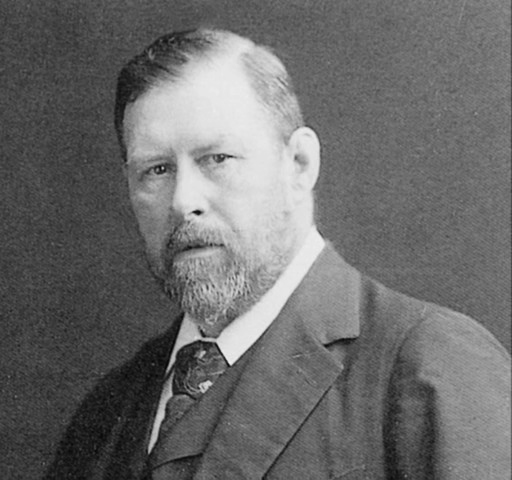 Photograph of the
noted Irish author of supernatural novels, Bram Stoker (1847-1912);
he was also the business manager of the Lyceum Theater and Henry
Irving's personal assistant for many years. Pamela Colman
Smith called him "Uncle Bramy." She provided the illustrations for
his last novel, The Lair of the White Worm (published in
1911). |
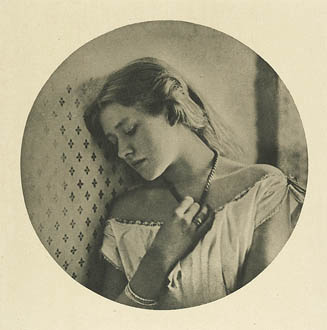 The great English
stage actress, Ellen Terry (1847-1928); this photograph was taken in
1864 when Terry was only 16 years old. The picture was taken by the
pioneering British portrait photographer, Julia Margaret Cameron
(1815-1879). After Pixie Smith relocated to England in 1900,
Ellen Terry and her business partner, Henry Irving, became like
second parents to the newly orphaned young American.
|
 Painting (pastel on
paper) of Ellen Terry's illegitimate daughter, Edith Craig
(1869-1947). This painting was done in 1911 by the English artist
Emmelina Deane.
Edith Craig was a good friend of Pamela Colman Smith. Craig became
almost like a sister to Smith, who had neither siblings nor living
parents. |
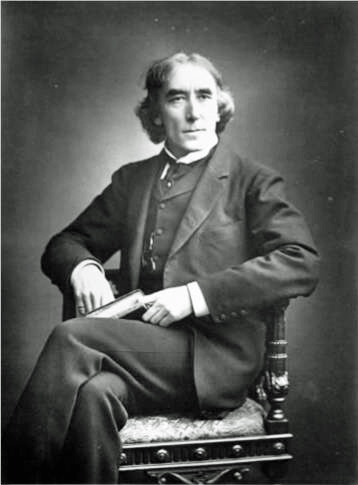
Photograph of the great English
stage actor, Sir Henry Irving (1838-1905). He was the manager and
lead actor of the Lyceum Theater Company in London. He and his
business partner, Ellen Terry, functioned almost like second parents
to the newly orphaned Pixie Smith until Irving's death in 1905. |
|
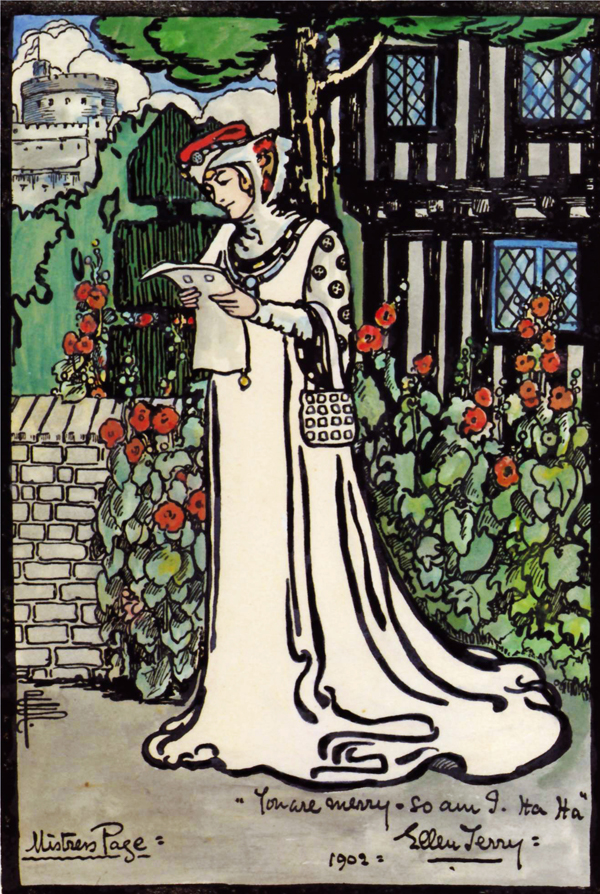
Ellen Terry as
Mistress Page |
In the Summer of 1899, Pamela
Colman Smith (PCS)
and her father made a trip to England. The English trip was made primarily to
investigate employment possibilities for PCS and promote her new book of
Jamaican folklore called Annancy Stories, which was being
published that same year. They called on Bram Stoker (1847-1912),
the author of Dracula (published 1897)and the business manager of the Lyceum Theatre in London. He told them about
the upcoming American tour of the Lyceum Theatre Troop, led by Sir
Henry Irving (1838-1905) and Ellen Terry (1847-1928). After his review
of her art portfolio, Stoker was sufficiently impressed to obtain her services
to illustrate an 18 page souvenir brochure that he was writing to be sold at
performances of the upcoming Lyceum Theatre tour. The brochure, with this
extremely long title:
Sir Henry Irving and
Miss Ellen Terry in Robespierre, Merchant of
Venice, The Bells, Nance Oldfield, The Amber Heart, Waterloo, and Other Dramatic
Works;
was published in New York by Doubleday and McClure, with copies available just
before the Lyceum tour was to begin on 30 October. PCS probably made her
drawings from photographs taken of previous performances, which were provided to
her by Stoker. In October 1899, PCS met
Stoker, Irving and Terry in New York and talked them into letting her
join the tour as one of the minor cast
members. She got along well with the troupe, especially with Ellen Terry who
gave her the
nickname of "Pixie."
In December 1899, Pamela's
father, Charles Edward Smith, unexpectedly died in New York.
|
|
After her father's death,
Pamela continued with the theater
tour and made several illustrations of scenes from the plays and also of the
costumes that were used. She had become close friends with both Ellen Terry and
with her illegitimate daughter, Edith "Edy" Craig (1869-1947). When the theater
company returned to England in late May 1900, Pamela returned with them. She was
now just 22 years old and all alone, but she was determined to make her own way
and become successful
as an artist. While on board ship, PCS made several sketches of the tour menbers and herself. One of the more amusing sketches is shown on the right.
With both her parents now dead
and without any siblings, it appears that Terry and Irving began to assume a de
facto parental role for this newly orphaned young girl. In London, she used her
theatrical connections to get jobs as a stage set designer at several London
theaters. Pamela began to use the
"Pixie" nickname that Ellen Terry had given her,
thus playing on her image as an artist whose life was totally immersed in the
fantasy life of children. Her persona was that of an authentic mystic with a
childlike voice. For several years thereafter, she occasionally would make public appearances with her head
wrapped in bright scarves and feathers, with a colorful costume resembling gypsy
attire. She would then recite West Indian nursery tales and chant ballads by
William Butler Yeats!
A few months after their
return, in mid-October 1900, the Lyceum Theatre group commenced a
nine-week provincial tour of Britain; PCS accompanies them, once again
playing a minor cast role. In all, eight cities were visited, including
Manchester, Liverpool, Edinburgh, and Glasgow, concluding in Brighton on
22 December 1900.
after 1900, Pamela's contact with
the Lyceum Theatre people was greatly reduced, but she continued her friendships
with several of them for many years thereafter.
Her subsequent contact with
Henry Irving was minimal; at best, his influence had been mostly that of a
distant patriarchal figure. Also, he had only a few years left to live, dying in
October 1905.
She retained a close
relationship with Ellen Terry for many years. In 1913, PCS illustrated
Ellen Terry's book
on Diaghilev's Ballets Russes which was published that same year. Ellen Terry
lived until 1928, but during her last years she was plagued with poor health and
serious psychological problems. Even so, as late as 1916, Terry was able to
write a letter to the United States Embassy in London, attesting to the U.S.
citizenship of Pamela Colman Smith.
In subsequent years PCS would
occasionally work with Edith Craig in stage design projects. Most notably, in
1904, she worked with Edy Craig on the stage design for the London production of
William Butler Yeats' play: Where There Is Nothing. The play premiered at
the Royal Court Theatre in London on 20 June 1904 and enjoyed a successful run. |
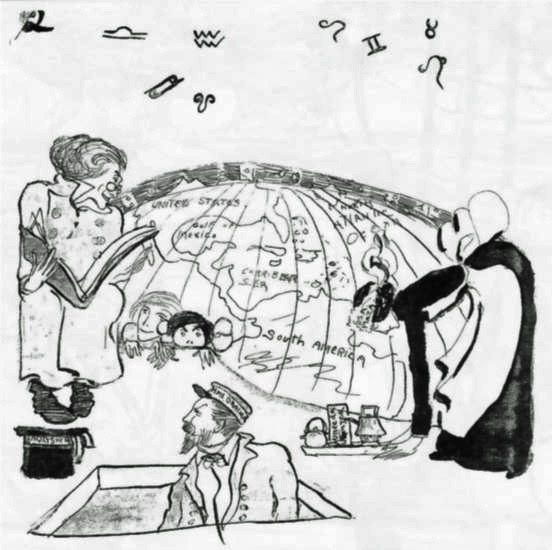
This sketch shows Pixie
Smith's impression of shipboard entertainment on the crossing from New
York back to England in late May 1900. From left to right: Sir Henry
Irving gives a lecture concerning ancient Egyptian hieroglyphics; Edith
Craig and Pixie Smith dutifully listen; Bram Stoker (Uncle Bramy) attaired as a coal
stoker emerges from the engine room wearing an "HMS Dracula" cap; Ellen
Terry dressed as a maid serves afternoon tea. |
|
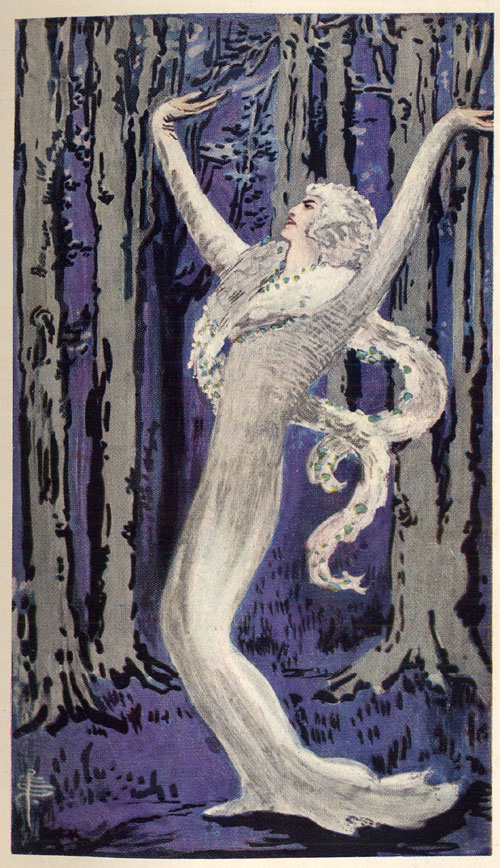
Illustration from
Lair of the White Worm |
In my opinion, of all her Lyceum friends, it
was her friendship with Bram Stoker (called Uncle Bramy by PCS) that may have
been the most significant. She remained a close friend of Stoker throughout the
Edwardian Era and provided the illustrations for his last novel The Lair of the
White Worm which was published in 1911, just one year before Stoker's death.
My personal opinion is that Stoker, like PCS, was a member of the Golden Dawn.
Stoker had probably been introduced to the Golden Dawn by several friends who were high ranking members,
e.g., the actress Florence
Farr (Chief Adept in Anglica); the lawyer John W. Brodie-Innes (Second Order,
Sixth Degree); and Oscar Wilde's wife, Constance Wilde (First Order, Fourth
Degree). One of the requirements of the Golden Dawn
training program is to create your own tarot deck for use during certain rituals
and meditations. Thus if Stoker was a member, he would have been very familiar
with the tarot and about the symbolism of the cards of the Major Arcana. The author of a
recent (1996) Bram Stoker
biography,
Barbara
Belford, believes that Stoker indeed was quite
familiar with the tarot and based many of his
characters in Dracula on tarot trumps. The numbered tarot trumps (from 1
through 21) contain an allegory about the search for enlightenment and
immortality; these are the same themes that are found in Dracula. Belford
tells us:
Throughout the novel there is a strong
undercurrent of the tarot, symbolic of the classical Gnostic quest. Jonathan
Harker, obviously the Fool, who journeys forth and encounters hazzards; he is
depicted on the cards as a young man carrying a knapsack and a rose, standing on
a precipice with his dog. During his travels Harker meets the Magician (Van
Helsing), the Empress (Mina), the Lovers (Lucy and Arthur), the Hermit (Seward),
the Devil (Dracula), and the Hanged Man (Quincy Morris.
The concept that the
Dracula novel is based upon the tarot Major Arcana has been taken and developed
upon by one of the world's foremost tarot experts,
Robert M Place. In 2009, he
published a book and associated
Vampire Tarot
deck based on the Dracula theme. |
References: 1)
Stuart R. Kaplan,
The Artwork and Times of Pamela Colman Smith (2009), pages 22, 49-54, 85-86.
2) Nina Auerbach, Ellen Terry Player in Her Time, (1987), page 350.
3) Barbara Belford, Bram Stoker, (1996), pages 213-214.
|